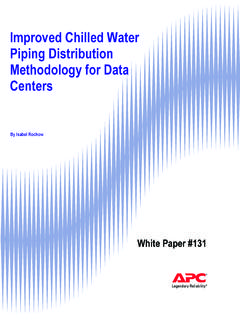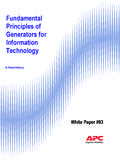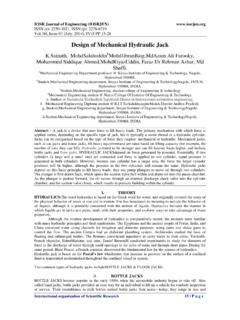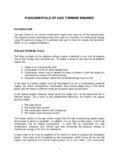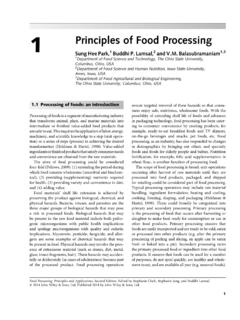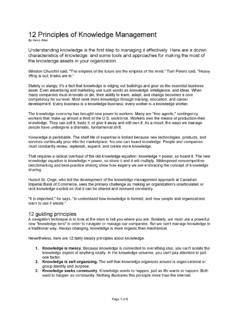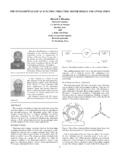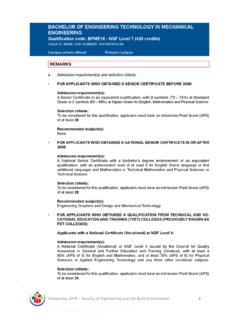Transcription of Fundamental Principles of Air Conditioners for …
1 Fundamental Principles of Air Conditioners for Information Technology By Tony Evans White Paper #57 Revision 2 Executive Summary Every Information Technology professional who is responsible for the operation of computing equipment needs to understand the function of air conditioning in the data center or network room. This introductory paper explains the function of basic components of an air conditioning system for a computer room. The concepts presented here are a foundation for allowing IT professionals to successfully specify, install, and operate critical facilities.
2 2004-2007 American Power Conversion. All rights reserved. No part of this publication may be used, reproduced, photocopied, transmitted, or stored in any retrieval system of any nature, without the written permission of the copyright owner. WP57 - 2 2 Introduction Whenever electrical power is being consumed in an Information Technology (IT) room or data center, heat is being generated that needs to be removed from the space. Data Center and IT room heat removal is one of the most essential yet least understood of all critical IT environment processes.
3 Improper or inadequate cooling significantly detracts from the lifespan and availability of IT equipment. A general understanding of the Fundamental Principles of air conditioning and the basic arrangement of precision cooling systems facilitates more precise communication among IT and cooling professionals when specifying, operating, or maintaining a cooling solution. This paper explains the basic operating Principles and major components of precision cooling systems from an IT perspective. It also provides basic concepts that are an essential foundation for the proper specification and design of data centers or network rooms.
4 This is an introductory paper from a suite of related papers on more advanced cooling topics from APC, and provides references for readers interested in a more complete treatment of the subject. The Nature of Heat in the IT Environment Heat is simply a form of energy. In the data center heat is produced as electricity is consumed by IT equipment. With few exceptions, over 99% of the electricity used to power IT equipment is converted into heat. Unless the excess heat energy is removed, room temperature will rise until IT equipment fails.
5 Approximately 50% of the heat energy released by servers originates in the microprocessor itself. A fan moves a stream of cooling air across the chip assembly. The server or rack-mounted blade assembly containing the microprocessors usually draws cooling air into the front of the chassis and exhausts it out of the rear as shown in Figure 1. The amount of heat generated by servers is on a rising trend. A single blade server chassis can release 4 Kilowatts (kW) of heat energy into the IT room or data center. Such a heat output is equivalent to the heat released by forty 100-Watt light bulbs and is actually more heat energy than the capacity of the heating element in many residential cooking ovens.
6 2004-2007 American Power Conversion. All rights reserved. No part of this publication may be used, reproduced, photocopied, transmitted, or stored in any retrieval system of any nature, without the written permission of the copyright owner. WP57 - 2 3 Figure 1 Microprocessor and server cooling airflow Front-to-back cooling air flow in a rack-mounted blade server chassis Microprocessor air-cooling A unique property of heat energy is that it can only flow in one direction, from hot to cold. For example a cold object placed in a hot room cannot drop in temperature it can only gain heat energy and rise in temperature.
7 It is for this reason that air Conditioners and refrigerators exist. They use electrical or mechanical energy to pump heat energy from one place to another, and are even capable of pumping heat from a cooler space to a warmer space. The ability to pump heat to the outdoors, even when it is hotter outside than it is in the data center, is a critical function that allows high-power computing equipment to operate in an enclosed space. Understanding how this is possible is a foundation to understanding the design and operation of cooling systems for IT installations.
8 The Refrigeration Cycle The actual movement of heat energy from the IT room to the outside atmosphere is achieved by use of the refrigeration cycle. It s the same process today that has been used for over 100 years. The refrigeration cycle is a closed cycle of evaporation, pressure change, condensation, and flow regulation applied to a fluid called refrigerant. Figure 2 shows the refrigeration cycle and its key components as they are applied to a typical IT environment. The specific processes and components are described below.
9 2004-2007 American Power Conversion. All rights reserved. No part of this publication may be used, reproduced, photocopied, transmitted, or stored in any retrieval system of any nature, without the written permission of the copyright owner. WP57 - 2 4 Figure 2 Heat energy removal via the refrigeration cycle Outdoor Environment IT EnvironmentHeatEnergyFan Expansion Valve Fan Refrigerant Flow Direction Evaporator Coil Condensing Coil Compressor Evaporation Evaporation is the first step in removing heat energy from a computer room.
10 The evaporator coil acts like an automobile radiator operating in reverse. Warm air from the computer room is blown across the evaporator coil by a fan, while the pipes comprising the coil are supplied with cold liquid refrigerant. (How the refrigerant comes to be cool is described later in the sequence). When the warm computer room air passes through the cold evaporator coil it is cooled and this cool air is delivered back to the computer room. Even though the evaporator coil is cold, at approximately 46 F ( C), the refrigerant inside is evaporating, or boiling, changing from liquid to a gaseous state1.


